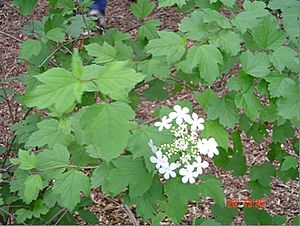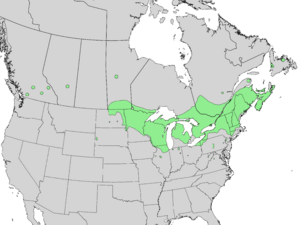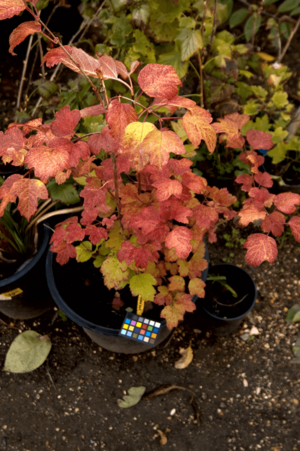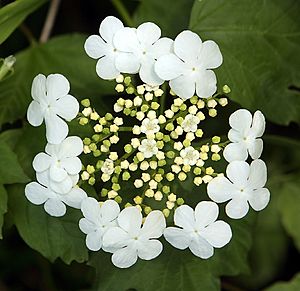Cranberrybush viburnum facts for kids
Quick facts for kids Cranberrybush viburnum |
|
|---|---|
 |
|
| Scientific classification | |
| Genus: |
Viburnum
|
| Species: |
trilobum
|
 |
|
| Natural range of Viburnum trilobum | |
The Viburnum trilobum is a cool plant often called the cranberrybush viburnum or American cranberrybush. It's a type of Viburnum shrub that grows naturally in northern North America. You can find it from Newfoundland all the way west to British Columbia, and south to Washington state and east to northern Virginia.
This plant is very similar to another one called Viburnum opulus, which grows in Europe and Asia. Because they are so alike, Viburnum trilobum is sometimes considered a special type (or variety) of Viburnum opulus.
Contents
What Does It Look Like?
The cranberrybush viburnum is a deciduous shrub. This means it's a woody plant that loses its leaves every fall. It can grow up to 4 meters (about 13 feet) tall.
Stems and Leaves
Its bark is gray and feels rough, with a scaly texture. The stems arch outwards and grow very close together, making the plant look dense. The younger twigs are a reddish-brown color.
The leaves grow in pairs opposite each other on the stem. They have three lobes, which means they are divided into three parts, a bit like some maple leaves. Each leaf is about 6 to 12 centimeters (2.5 to 4.5 inches) long and 5 to 10 centimeters (2 to 4 inches) wide. The edges of the leaves are serrated, meaning they have small, sharp teeth. You can tell them apart from maple leaves because their surface looks a bit wrinkled, and the veins are pressed into the leaf. The leaf buds are green.
Flowers and Fruit
The flowers are white and grow in flat-topped clusters called corymbs. These clusters can be up to 13 centimeters (5 inches) across and appear at the top of the stems. Each cluster has two kinds of flowers:
- Outer flowers: These are larger, about 2 to 2.5 centimeters (0.8 to 1 inch) wide, with noticeable petals. They don't produce seeds.
- Inner flowers: These are much smaller, about 5 millimeters (0.2 inches) wide, and are the ones that can produce fruit.
Insects help pollinate the flowers, which means they help the plant make seeds.
The fruit is a bright red, oval-shaped drupe. A drupe is a fruit with a fleshy outside and a hard pit or stone inside, like a peach or a cherry. Each fruit is about 15 millimeters (0.6 inches) long and 12 millimeters (0.5 inches) wide. Inside, there's a single flat, white seed.
Plants usually start making fruit when they are about five years old. When animals, like birds, eat the fruits, they help spread the seeds to new places through their droppings.
What Is It Used For?
Even though it's often called "highbush cranberry," this plant is not a true cranberry. The name comes from its red fruits, which look a lot like cranberries and ripen around the same time of year. They also have a similar tart flavor.
After you remove the large seeds, the fruits can be eaten raw or cooked. They are quite sour but are full of vitamin C. People often cook them into a sauce to serve with meat or game, similar to how you might use real cranberries.
Pests and Plant Problems
One common problem for the cranberrybush viburnum is the Viburnum leaf beetle. Both the young beetles (larvae) and the adult beetles like to eat the leaves of the plant. If they eat too many leaves, it can completely strip the plant bare. If this happens many times, it can even kill the plant.
Its Place in Culture
This berry is very important in the cultures of western Canada. Many different groups of people, including both First Nations (Native) peoples and people of European background, have used these berries for many years.
The Canadian French name for these berries is pembina. This name was then used for three different rivers: one that flows through Manitoba and North Dakota, another in Ontario, and a third in Alberta.



